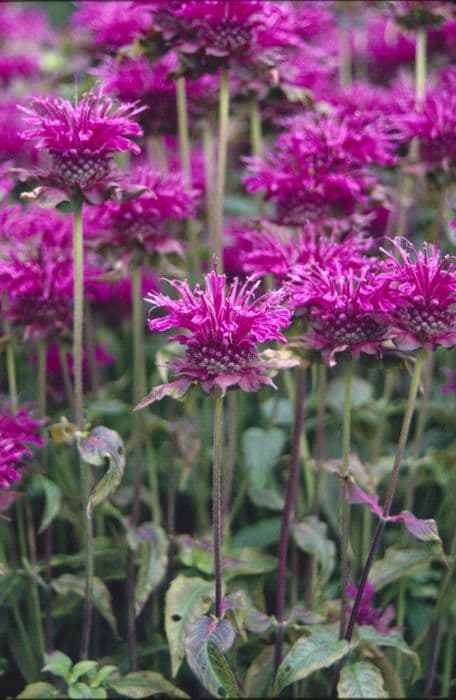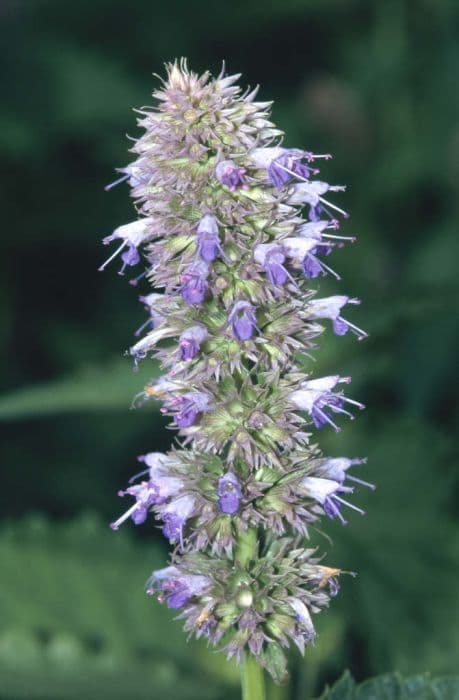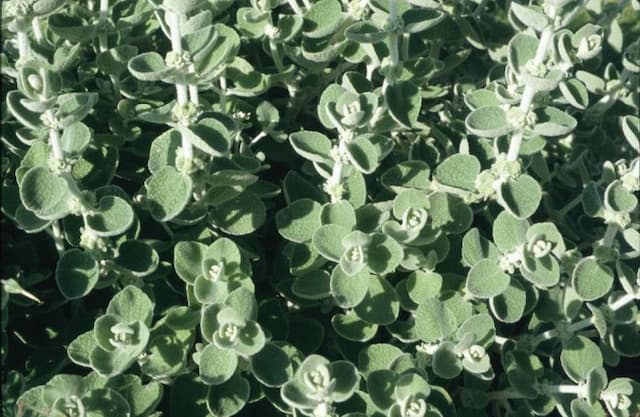Bergamot Monarda 'Scorpion'

ABOUT
Monarda 'Scorpion' is characterized by its vibrant, tubular flowers that can range in color, typically showcasing shades of purple and burgundy. The blooms cluster in a dome-like shape at the top of the stems and are known for their striking, feathery appearance, which is due to the small, leafy bracts that extend out from each flower cluster. These flower clusters are not only eye-catching but are also a magnet for pollinators such as bees, butterflies, and hummingbirds. The foliage of Monarda 'Scorpion' consists of lance-shaped leaves that are slightly serrated at the edges, emanating a pleasant fragrance when crushed. The leaves are a deep green color, which contrasts beautifully with the bold color of the flowers. The plant has a bushy growth habit, forming dense clumps of stems and leaves, making it an excellent choice for borders or as part of a mixed garden bed. Overall, Monarda 'Scorpion' exudes a wild, yet elegant charm that can brighten up any garden with its vivid blooms and fragrant foliage, providing a long season of visual interest and aromatic allure.
About this plant
 Names
NamesFamily
Lamiaceae.
Synonyms
Bergamot, Bee Balm, Horsemint, Oswego Tea.
Common names
Monarda 'Scorpion'
 Toxicity
ToxicityTo humans
Bee balm, which is the common name for Monarda 'Scorpion', is not known to be toxic to humans. Generally, it is considered safe and is even used in some culinary applications for its minty, spicy flavor. However, if consumed in excessive amounts, it could potentially lead to stomach upset owing to its strong oils and compounds. Always consult with a medical professional or a qualified herbalist before using bee balm for medicinal purposes to avoid any possible adverse reactions.
To pets
Bee balm is not recognized as toxic to pets. It is not typically associated with poisoning or serious side effects if pets happen to consume it. However, as with any plant not specifically intended for animal consumption, ingestion in large quantities could potentially cause mild gastrointestinal upset, such as vomiting or diarrhea, in some pets. It is always best to monitor your pets around plants and discourage them from chewing on any type of foliage to prevent any possible negative reactions.
 Characteristics
CharacteristicsLife cycle
Perennials
Foliage type
Deciduous
Color of leaves
Green
Flower color
Purple
Height
2-3 feet (0.6-0.9 meters)
Spread
2-3 feet (0.6-0.9 meters)
Plant type
Herb
Hardiness zones
4
Native area
North America
Benefits
 General Benefits
General Benefits- Attracts pollinators: Monarda 'Scorpion' is highly attractive to bees, butterflies, and hummingbirds, providing a valuable nectar source.
- Aesthetic appeal: With its vibrant purple flowers, the plant adds striking color and beauty to gardens.
- Aromatherapy: The plant emits a pleasant fragrance, adding an aromatic experience to outdoor spaces.
- Culinary use: Parts of the plant can be used in teas and as a flavoring, enriching culinary experiences.
- Drought tolerance: Once established, Monarda 'Scorpion' has good tolerance to dry conditions, reducing the need for frequent watering.
- Easy to grow: It is generally easy to care for and does not require special gardening skills or attention.
- Seasonal interest: The plant blooms in mid to late summer, providing seasonal interest in the garden during these times.
- Naturalizing: Monarda 'Scorpion' can spread and naturalize in an area, filling out the landscape organically over time.
- Garden design: It can be used in various garden designs, including cottage gardens, wildlife gardens, and perennial borders.
 Medical Properties
Medical Properties- Antiseptic - The essential oil of Bee Balm has been used for its antiseptic properties.
- Carminative - It is known to help reduce gas and bloating.
- Diaphoretic - Bee Balm can induce sweating, which is historically believed to help in fever reduction.
- Antispasmodic - It may relieve muscle spasms or cramps.
- Antimicrobial - Components in Bee Balm might inhibit the growth of certain bacteria and fungi.
- Digestive Aid - There is limited evidence that suggests it may help with digestive issues.
 Air-purifying Qualities
Air-purifying QualitiesThis plant is not specifically known for air purifying qualities.
 Other Uses
Other Uses- Bee Balm 'Scorpion' can be used as a natural flavoring in foods; its leaves have a minty taste suitable for culinary purposes.
- The flowers of Bee Balm 'Scorpion' can be crystallized and used as edible decorations on cakes and desserts.
- You can use dried Bee Balm 'Scorpion' to create a fragrant potpourri that freshens up your living space.
- Bee Balm 'Scorpion' plant matter can be added to compost to enrich the soil with nutrients as it breaks down.
- Leaves of the Bee Balm 'Scorpion' can be infused in water to create a natural insect repellent spray for plants.
- The Bee Balm 'Scorpion' can be used as a natural dye, providing a soft color to fabrics or crafts when boiled down.
- When dried, the flowers of Bee Balm 'Scorpion' can be woven into aromatic wreaths or garlands.
- Bee Balm 'Scorpion' leaves can be rubbed onto the skin as a natural mosquito repellent due to their strong scent.
- Fresh Bee Balm 'Scorpion' can be placed in drawers or closets to impart a pleasant aroma to linens and clothing.
- The Bee Balm 'Scorpion' is a nectar-rich plant that can attract and support populations of beneficial insects, such as butterflies and hummingbirds.
Interesting Facts
 Feng Shui
Feng ShuiThe Bergamot is not used in Feng Shui practice.
 Zodiac Sign Compitability
Zodiac Sign CompitabilityThe Bergamot is not used in astrology practice.
 Plant Symbolism
Plant Symbolism- Attraction: Known commonly as Bee Balm, Monarda 'Scorpion' is highly attractive to bees and butterflies, symbolizing an irresistible allure and the power of attraction.
- Healing: Bee Balm has a history of medicinal use by Native Americans, symbolizing restoration and the healing of physical or emotional ailments.
- Prosperity: The abundance of flowers and their vibrant color are often associated with prosperity and the flourishing of resources.
- Brightness: The bright blossoms of Bee Balm symbolize cheerfulness, positive energy, and bringing light to one's life.
- Balance: Monarda 'Scorpion' has a natural balance in its form and fragrance, often symbolizing equilibrium and harmony in one's existence.
 Water
WaterBee Balm should be watered deeply once or twice a week, depending on the climate and soil conditions. Aim to provide about an inch of water weekly, potentially adjusting during particularly hot or dry periods. It is best to water at the base of the plant to avoid wetting the foliage, which can lead to fungal diseases. During the growing season, if there isn't significant rainfall, you might need to supplement with additional water, possibly using up to two gallons per plant each watering session, especially in well-draining soils.
 Light
LightBee Balm thrives in full sun to partial shade. Ideally, it should receive at least six hours of direct sunlight daily. The best spot for planting Bee Balm would be a location where it has plenty of morning sunlight and some afternoon shade, particularly in hotter climates to prevent scorching.
 Temperature
TemperatureBee Balm performs well in a wide range of temperatures, ideally between 60 to 70 degrees Fahrenheit. It can tolerate temperatures as low as the upper 30s for short periods but should be protected from frost. High temperatures over the mid-80s may stress the plant, especially if humidity is low.
 Pruning
PruningPruning Bee Balm is essential for maintaining plant health and encouraging vigorous blooming. Deadhead spent flowers throughout the growing season to promote new blooms. At the end of the growing season, cut the plant back to a few inches above the ground. This not only tidies up the garden but also helps prevent disease and can rejuvenate the plant for the next season. Prune Bee Balm in late fall or early spring before new growth begins.
 Cleaning
CleaningAs needed
 Soil
SoilBee Balm 'Scorpion' thrives in well-drained soil enriched with organic matter, with a preferred pH range between 6.0 and 7.0. A mix of loam, compost, and a small amount of sand can create optimal conditions.
 Repotting
RepottingBee Balm 'Scorpion' doesn't typically need frequent repotting as it is often grown as a perennial in gardens. Division every 2-3 years can rejuvenate overcrowded clumps.
 Humidity & Misting
Humidity & MistingBee Balm 'Scorpion' prefers moderate to high humidity levels but is quite adaptable to various atmospheric moisture conditions as long as it's not in an arid environment.
 Suitable locations
Suitable locationsIndoor
Provide bright light and good air circulation.
Outdoor
Plant in sun to part-shade with good air flow.
Hardiness zone
4-9 USDA
 Life cycle
Life cycleThe Monarda 'Scorpion', commonly known as bergamot or bee balm, begins its life as a seed, which when sown and in the presence of warmth and moisture, germinates. The seed develops into a small seedling with a few leaves, which establishes a root system and gradually matures into a vegetative plant. As the plant grows, it forms a clump with upright stems and dark green foliage. Once mature, usually in the second year, it produces distinctive tubular flowers ranging in color from purple to pink in mid to late summer, which are attractive to pollinators like bees, butterflies, and hummingbirds. After flowering, the plant produces seeds, which can be dispersed to propagate new plants. Come autumn, the bergamot's aboveground parts die back, and the plant enters a period of dormancy through the winter, with the roots surviving to sprout again the following spring.
 Propogation
PropogationPropogation time
Spring-Early Summer
Monarda 'Scorpion', commonly known as Bee Balm, is most frequently propagated through division, which is best done in the spring or fall when the plant is not in peak bloom. To propagate by division, you'll firstly need to dig up the entire plant, making sure you get as much of the root system as possible. Gently separate the plant into smaller sections by either teasing the roots apart with your fingers or cutting them with a sharp knife or spade; each division should have several shoots and a healthy portion of roots. Replant the divisions immediately at the same depth they were growing at previously, spacing them about 18 to 24 inches (45 to 60 centimeters) apart to allow for growth. Water the new plantings thoroughly to settle the soil around the roots and continue to provide water until the plants are established. This method helps to rejuvenate older clumps that may have become woody or less vigorous and also allows gardeners to create more plants to expand their gardens or share with others.









